Barrett M107A1 50 BMG 20" 10rd Rifle, Black – 18062-S For Sale
$10,999.99
The Barrett M107A1 50 BMG 20″ 10rd Rifle is a sophisticated, lightweight firearm engineered for excellence in suppressed shooting. This upgraded version of the classic Barrett M107 integrates advanced features for noise reduction, including a newly designed bolt carrier group that is suppressor-ready and a steel four-port cylindrical muzzle brake for quick suppressor attachment. The rifle boasts a lightweight aluminum upper receiver with a 27 MOA optics rail for mounting precision optics, and its durable construction features a chrome-lined bore and chamber, a robust recoil buffer system, and a titanium barrel key. User comfort is prioritized with a thermal-guard cheek piece and a newly designed adjustable monopod, enhancing stability. Maintenance is simplified with protective coatings on the bolt carrier, while the entire rifle showcases meticulous craftsmanship, as demonstrated by numbered witness holes on the magazine. This combination of advanced technology, user comfort, and durability makes the Barrett M107A1 a desirable choice for firearm enthusiasts seeking high-performance suppressed capabilities.
What is the difference between M107A1 and M82A1?
The M107A1 and M82A1 are both .50 caliber sniper rifles developed by Barrett, but there are key differences between them:
1. **Weight and Design**:
– **M107A1**: It is a lighter version of the M82A1, designed with modern materials such as titanium, which reduces its weight. The M107A1 is also optimized for suppressor use.
– **M82A1**: This is the original Barrett semi-automatic sniper rifle, heavier due to its traditional materials and design.
2. **Suppressor Compatibility**:
– **M107A1**: Built with suppressor compatibility in mind, the M107A1 features modifications such as an improved recoil and gas system to accommodate a suppressor.
– **M82A1**: While a suppressor can be used, the M82A1 is not designed specifically for that purpose and doesn’t have the same mitigations for suppressor use as the M107A1.
3. **Recoil and Gas System**:
– **M107A1**: It has an improved recoil and gas system which aids in reducing the stress on the weapon system and user when fired with or without a suppressor.
– **M82A1**: It has the original recoil and gas system which is effective but not optimized for some modern accessories like suppressors.
Overall, the M107A1 represents a modernized, slightly lighter, and suppressor-friendly evolution of the M82A1, built with updates to materials and design for improved tactical versatility.
Can you legally own a Barrett 50 cal?
Yes, in the United States, it is legal for civilians to own a Barrett .50 caliber rifle, provided they comply with federal, state, and local laws. Generally, this involves passing a background check and possibly adhering to specific state regulations. It’s important to note that laws can vary significantly by jurisdiction, so it’s advisable to check the specific laws in your state or region.
What is the range of the m107a1 sniper rifle?
The Barrett M107A1 sniper rifle has an effective range of approximately 1,800 meters (about 1,968 yards). However, experienced shooters may achieve hits at longer distances under optimal conditions.
Are Barrett rifles worth the money?
Barrett rifles are often considered worth the investment by those who need their specific capabilities. Known for their long-range accuracy and powerful calibers, such as the .50 BMG, they are highly valued by military, law enforcement, and enthusiasts for applications that require extreme precision and stopping power. However, they are expensive, heavy, and may not be practical for casual shooters or hunters. Their value depends on your specific requirements and usage intentions.
Is the 416 Barrett better than the 50 BMG?
The comparison between the .416 Barrett and the .50 BMG (Browning Machine Gun) cartridges depends on the specific criteria being considered:
1. **Ballistics and Accuracy**: The .416 Barrett was developed for long-range precision shooting and offers excellent accuracy. It typically has a flatter trajectory and less wind drift compared to the .50 BMG, which can make it more appealing for long-range marksmanship.
2. **Range and Energy**: While both cartridges are suitable for extreme long-range shooting, the .50 BMG generally carries more kinetic energy due to its larger size, making it more effective for anti-material roles where stopping power is important.
3. **Recoil and Weight**: The .416 Barrett generally has less recoil than the .50 BMG, which can be advantageous for shooters seeking better control and quicker follow-up shots.
4. **Availability and Cost**: The .50 BMG is more widely available and has been in use for a longer time, which can make it easier and sometimes cheaper to find compared to the newer and more specialized .416 Barrett.
5. **Intended Use**: The .50 BMG is popular for both military and civilian applications that involve heavy rifles and anti-material purposes. The .416 Barrett, on the other hand, is often chosen for competitive shooting and scenarios where precision at extreme ranges is a priority.
Ultimately, whether the .416 Barrett is “better” than the .50 BMG depends on your specific needs and intended use. For precision, long-range shooting, the .416 Barrett might be preferred, while for general versatility and sheer power, the .50 BMG could be the better choice.
Is the M107 a sniper rifle?
Yes, the M107 is a sniper rifle. It is a variant of the Barrett M82, a semi-automatic, long-range, anti-material sniper rifle.
What states ban 50 cal rifles?
As of the latest available information, California is the only state in the United States that has enacted a specific ban on .50 caliber rifles. The legislation prohibits the sale, distribution, and manufacturing of these firearms within the state. However, regulations can change, so it is important to check with local laws or legal authorities for the most current information.
What does BMG stand for in guns?
BMG in guns stands for “Browning Machine Gun.” It is often associated with the .50 BMG (12.7×99mm NATO) cartridge, which was developed for the Browning M2 machine gun.
Can you hunt deer with a Barrett 50 cal?
Hunting regulations vary by location, so it’s essential to check the specific laws in your area. In many places, using a Barrett .50 cal for deer hunting might be legal, but it is generally not recommended due to its excessive power. This caliber is designed for long-range military purposes and could cause unnecessary damage to the animal and pose safety risks to the surrounding area. Always ensure you’re using an appropriate caliber for the game you’re hunting and following all local hunting regulations.
What sniper did Chris Kyle use?
Chris Kyle primarily used the McMillan TAC-338 sniper rifle and the MK 12 SPR during his military service.
What sniper rifle is used by secret service?
The U.S. Secret Service has traditionally been known to use several sniper rifles for protective duties, one of the more common models being the Remington 700. Variants of the Remington 700 are often customized to meet specific agency requirements. However, details about current equipment can vary, and the specific models in use may change over time as technology advances and operational needs evolve.
What is the best sniper rifle in the world?
Determining the “best” sniper rifle in the world can depend on various factors, including range, accuracy, reliability, and intended use. Some of the top sniper rifles often mentioned for their performance include:
1. **Barrett M82/M107**: Known for its long-range capabilities and .50 BMG caliber, it’s widely used by military forces.
2. **Accuracy International AWM (Arctic Warfare Magnum)**: Famous for its precision and long-range accuracy, chambered in calibers like .338 Lapua Magnum.
3. **CheyTac M200 Intervention**: Designed for ultra-long-range engagements, chambered in .408 CheyTac.
4. **Sako TRG-42**: Known for its accuracy in various conditions, commonly chambered in .338 Lapua Magnum.
5. **Remington MSR (Modular Sniper Rifle)**: Offers modularity and reliability, adaptable to different calibers.
Each of these rifles excels in specific situations, so the “best” one can vary based on the needs and preferences of the user.
What is the difference between 50 cal and 50bmg?
The “.50 cal” generally refers to any firearm or ammunition with a bullet diameter of .50 inches. The term “.50 BMG,” on the other hand, specifically refers to the .50 Browning Machine Gun cartridge. Here are the key differences:
1. **Scope**: “.50 cal” is a generic term that can refer to different types of cartridges with a .50-inch diameter. “.50 BMG” refers specifically to the 12.7×99mm NATO cartridge, which was developed for the Browning .50 caliber machine gun.
2. **Usage**: The .50 BMG is used in both machine guns and sniper rifles. It’s known for its long-range capabilities and powerful impact, making it a popular choice for military and certain law enforcement use.
3. **Specifications**: The .50 BMG is a specific size and type of round, with precise dimensions: 12.7mm in diameter and 99mm in length. Other .50 caliber rounds might have different lengths or case specifics.
4. **Purpose**: While the .50 BMG is designed for both anti-materiel and sniper purposes, other .50 cal cartridges might be used for different applications, such as handguns or civilian firearms.
In summary, “50 cal” is a broader category, while “.50 BMG” is a specific type of ammunition within that category.
What is the difference between the Barrett M95 and M107?
The Barrett M95 and M107 are both high-caliber sniper rifles produced by Barrett Firearms, but they have several key differences:
1. **Design**:
– The M95 is a bolt-action rifle, which means it requires manual cycling of the action between shots. This design typically allows for higher accuracy due to fewer moving parts when a shot is fired.
– The M107, on the other hand, is a semi-automatic rifle, based on the Barrett M82 design. This allows for quicker follow-up shots as the action is cycled automatically with each pull of the trigger.
2. **Caliber**:
– Both rifles commonly use the .50 BMG (Browning Machine Gun) caliber, making them capable of long-range shooting and anti-material targeting. However, slight model-specific variations may exist depending on specific military or market requirements.
3. **Weight and Size**:
– Due to its simpler bolt-action design, the M95 tends to be lighter and more compact than the M107, making it easier to transport and handle in certain situations.
4. **Intended Use**:
– The M95, being a bolt-action, is often favored for roles where precision is prioritized over rate of fire, such as extreme long-range sniping.
– The M107 is suitable for situations requiring rapid successive shots, such as engaging multiple targets quickly or when a higher volume of fire is advantageous.
5. **Maintenance and Reliability**:
– The M95, with fewer moving parts, usually requires less maintenance compared to the more complex semi-automatic M107, which needs more care to ensure reliability.
These differences make each rifle suitable for different tactical roles depending on the mission requirements.
What is the speed of the Barrett M107A1 bullet?
The Barrett M107A1, which is a type of .50 BMG sniper rifle, typically fires bullets at a muzzle velocity of approximately 2,800 to 2,900 feet per second (around 853 to 884 meters per second), depending on the specific ammunition used.
| Model | M107A1 S |
|---|---|
| Action | Semi-Auto |
| Overall Length | 48" |
| Hand Orientation | Right Hand |
| Sights | Flip Up Rear |
| Twist | 1 |
| Grips | Black Polymer |
| Barrel Finish | Black |
| Receiver Material | Aluminum |
| Receiver Finish | Black Cerakote |
| Stock Finish | Black |
| Stock Material | Synthetic |
Be the first to review “Barrett M107A1 50 BMG 20" 10rd Rifle, Black – 18062-S” Cancel reply
Related products
Barrett M107A1
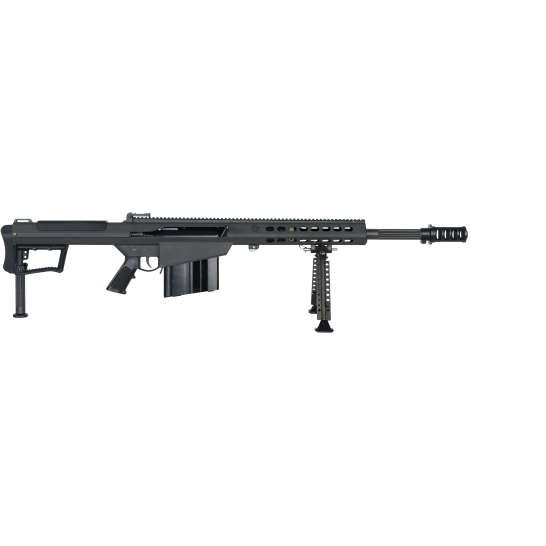
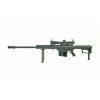
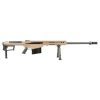
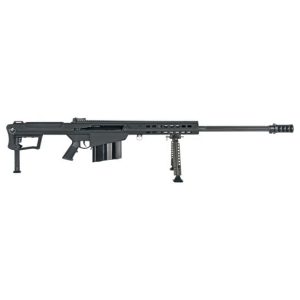
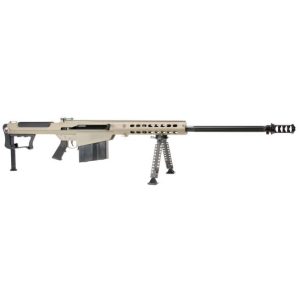
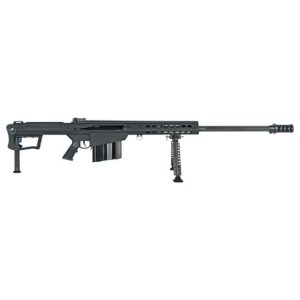
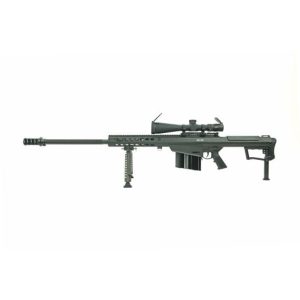
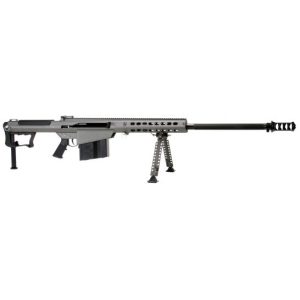
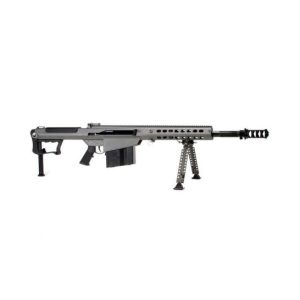
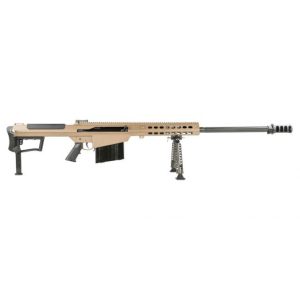
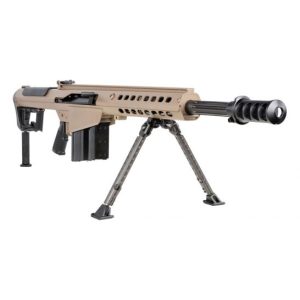
Reviews
There are no reviews yet.